We all want to be the creator of the next innovative SaaS marketing strategy. But the truth is that crafting a strategy that truly diverts from the norm is harder than it sounds.
We know. We’ve been there. Crafting our own innovative take on Marketing for SaaS has taken some time and quite a bit of investment. But boy does the dividends pay off when you hit the mark.
As is the case with many industries, choosing tried, true, and tested strategies are the quickest way to success. After all, Newton said it best:
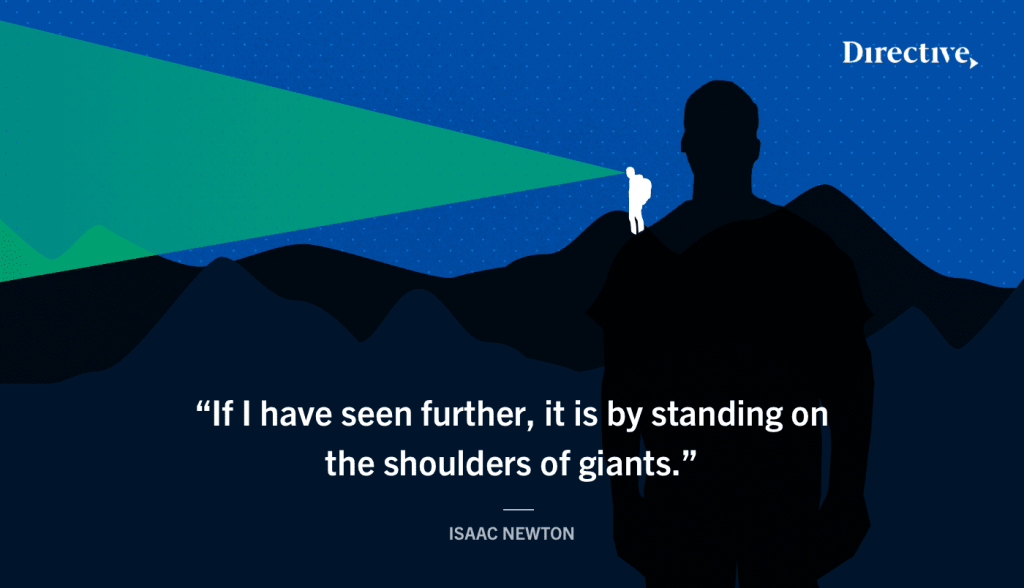
And if you aren’t willing to invest a large amount of your budget towards testing for yourself, learning from thought leadership is a great place to start. So let’s see what defines a SaaS marketing strategy and – more importantly – what distinguishes a big winner from a budget burner.
SaaS Marketing Strategy Defined
A SaaS marketing strategy at its core is a strategy focused on generating awareness, demand, leads, sales, activation, or retention for software and software-as-a-service companies.
You may have noticed that as opposed to the usual 3-point list of demand, leads, and sales, SaaS marketing strategies have a few more components. Why is this? Because the SaaS marketplace as a whole has a uniquely elongated customer journey and B2B sales cycle.
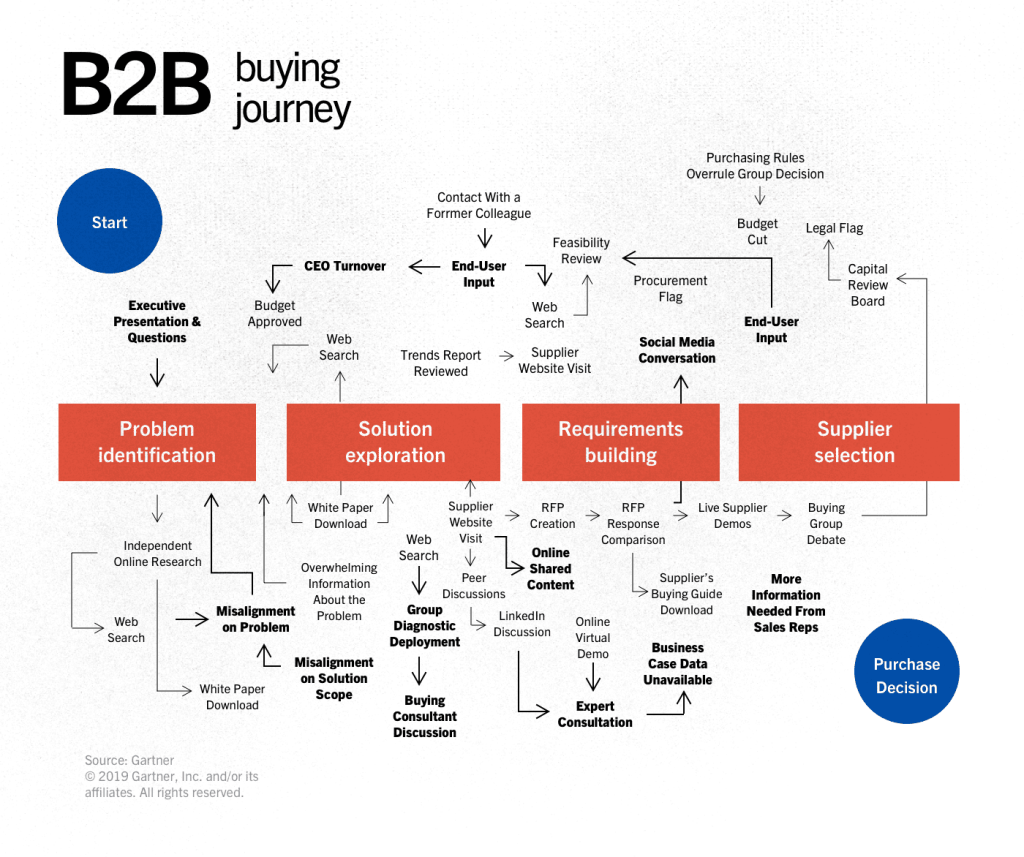
As opposed to more traditional B2C or eCommerce based transactions, there isn’t exactly a physical product for you to take home when it comes to SaaS. Because of this lack of finality in the actual closing conversion, the sales cycle can last quite a while. And by sales cycle, we mean the consideration phase of the sales cycle – or what we prefer to call the customer journey.
And this extended B2B customer journey is crucial to developing a successful SaaS marketing strategy. Understanding the consistency and duration necessary to close these sophisticated B2B tech leads can greatly impact your goal setting and resource allocation.
More importantly – crafting strategies that tailor to your customer’s extended journey instead of your brand’s continued value, can make all the difference. We are now moving past a world of product-based marketing and into a world of customer-led marketing for SaaS.
And here’s the catch: Most SaaS marketing strategies fail because they are not going with a customer-led approach.
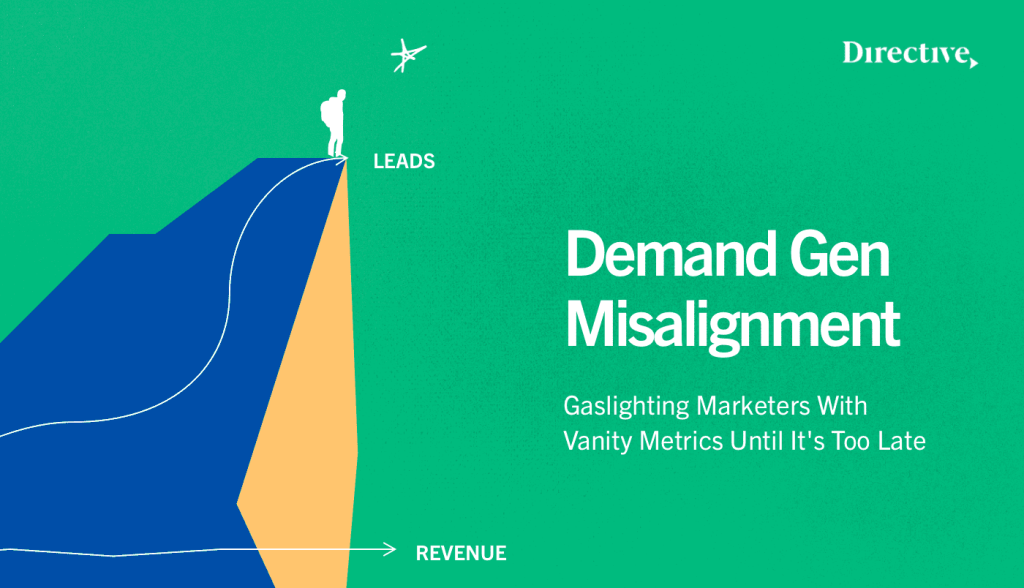
Now, don’t worry, we won’t leave you hanging. To make sure that you’re properly prepared for 2022, we’ve collected 11 of our favorite SaaS marketing strategies – each with a unique customer-led approach. Hop on our shoulders and let’s go for a ride, it’s time to generate some customers this holiday season.
11 Proven SaaS Marketing Strategy Staples
Here we get to the fun part. So I’ll skip all the introductions and get straight to the juice. As I mentioned earlier, the best way to build a strong starting SaaS marketing strategy is to build on the shoulders of giants.
So, to make things easy for you, here are 11 of our favorite tried-and-true SaaS marketing strategies that drive legitimate growth.
User-Driven Search Targeting
When it comes to SaaS SEO we all like to think that we have the best take on our keywords possible. But the truth is that most marketers get caught up with keyword tools and search volume data when crafting their organic content strategies. As helpful as the guiding tools can be, that’s exactly what they are – guides.
Instead of targeting the largest keyword volumes in your related industry, it’s high time we all consider a more “quality over quantity” approach.
By reverse-engineering your keyword research based on use-case-driven queries and Jobs To Be Done of your ICP, you can create far more valuable and targeted content. Content that will impress your actual end-buyers instead of just impressing the Google bots.
“It’s truly amazing what can be achieved when you look at SEO and Content in a holistic manner that caters to the actual customer as opposed to search engines”
– Brian Glassman | Account Director, Directive
And if you think that lopping off the majority of your keyword volume is too big of a risk to take, think again. When Directive pivoted ZEROFox’s keyword strategy and SEO silos to target user-driven search queries they saw some truly award-winning results:
- 20% Increase In Organic Traffic
- 101% Increase In Leads
- 2 New Pages Ranking in Top 5
The Skyscraper Approach
If we’re talking about staple SEO strategies we can’t forget the skyscraper technique. If you’re new to the game and don’t know what it refers to, the skyscraper technique is an SEO and content marketing strategy intended to create high-quality, linkable content that ranks fast.
The basics of the strategy are as straightforward as you can get:
- Step 1: Find link-worthy content
- Step 2: Make something even better
- Step 3: Reach out to the right people
The “skyscraper” in the name comes from the old metaphor that if you want to build the tallest building (best ranking piece of content) then take the blueprint of the current tallest building, slap on 20 more floors, and go from there! In a space like SEO where we are constantly trying to find out what our audience is engaging with, working with what’s most popular currently is always a good place to start.
Cornerstone Internal Linking
Speaking of linking, SaaS SEO includes far more than just your content’s external discoverability. Just because someone finds your brand’s blog via Google doesn’t mean they’ve necessarily found the right piece of content for them.
This is where your internal linking strategy needs to be more elaborate than simply linking to whatever relevant anchor text you might end up typing.
Customer-aligned cornerstone content allows you to target both high-volume keywords as well as targeted user-driven search queries all ways facilitating user navigation of your site.
Creating large, in-depth, “premier pieces” on high-volume primary keywords creates evergreen assets that Google loves to crawl and rank. At the same time, these large pieces serve as great internal linking hubs for you to subtly promote your more targeted and nuanced pieces of content.
This way, as practitioners read through your cornerstone piece to beef up their knowledge base and the inevitable executive question pops up, you can have a helpful internal piece of content ready to answer that question already linked.
This not only helps your reader and potential customer but also increases their on-site time and post engagement while increasing the views of your smaller pieces – which boosts SEO across the board.
Reverse-IP Tracking Customization
I’m sure you knew this already, but there are quite a lot of advanced tools out there for SaaS marketers to use. One of our favorite software strategies is reverse-IP tracking for customized on-site messaging.
Using tools like Clearbit and Mutiny together, you can track the IPs of the visitors of your site and cross-reference them with your existing account list. If the IP matches with one of the brands on your list, you can customize the messaging of your banners and chatbots to say “Hello [Company X] – how can we help you?”
A personal greeting upon arrival can make all the difference, especially in the overlay enterprise world of B2B SaaS. Remember, we’re trying to connect with brands and people at the end of the day, not just email accounts.
Brand Advertising
It may seem like an obvious move, but investing in the strength of your brand pays off. Maybe not immediately. But in the world of Silicon Valley where high value leaders hop from company to company, maintaining a strong brand reputation can make all the difference for your retention and your growth.
And to be clear – brand advertising goes far beyond just bidding on your own domain name as a primary keyword!
Your brand is an investment. And just like any advertising agency would tell any client, you need to invest significant budget and time in any growth campaign in order to see statistically significant growth. You can’t put your brand budget on the back burner and expect to grow simply by word of mouth. It’s a competitive space these days, and maintaining top of mind presence is vital if you want to keep your pipeline active throughout the year.
TAM Isolated Targeting
Contrary to what your product team might be telling you, your software isn’t for everyone. But here’s the kicker to that hard truth: operating on the assumption that you can help everyone on Google is actually burning the majority of your budget.
Instead of focusing on third party data and click-based campaigns that burn budget on unqualified engagements, focus on the end customer you’re trying to reach from the get go.
Crafting a clean, qualified, and verified account list or list of your Total Addressable Market (TAM) to isolate your advertising guarantees that every dime you spend is dedicated towards a potential customer. This is one of the strongest first steps you can take towards cleaning up your financial modeling.
When you know that every scent you spend is dedicated towards potential revenue instead of a blind marketing engagement, scaling that budget with confidence comes much easier.
Device Specific Targeting
Because we’re talking about customer-led SaaS marketing strategies and we’ve hopped into the shoes of our customers, why not take it one step further? Let’s take a moment to consider how specific SaaS sub industries can really get when you know your customers.
For example, certain government-contract based companies that focus on specific market segments have found that government employees and contracts tend to lean on Microsoft products over Apple. If you know that you’re going to be targeting this TAM, why would you even bother with Google Ads?
When you can customize your platform of choice (like Bing) or even the device your ads are targeting (like Microsoft tablets), you can actually further eliminate budget burn to make your campaigns even more targeted and effective.
When you look at what Directive was able to do for Pelican with a similar strategy, the reason behind device-specific targeting becomes quite clear.
Directive’ dedicated landing page strategy and sophisticated audience segment increased Pelican’s conversion rates by 170% while also decreasing their CPL by 34% for Microsoft Ads (Bing).
More importantly, we were able to boost Pelican’s lead generation output by 210% for their government-focused market segment that was reliant on Microsoft Tablet devices.
Free Demos & Downloads
It may go against the gated grain, but ungating some of your most valuable content assets can do wonders for your customer engagement. For example, when you know that scheduling is such a pain point for most modern day business executives, eliminating the friction of time juggling can create huge conversion lifts.
Instead of using “Schedule a Demo” as your CTA and linking to your Calendly (even though it is an industry favorite), try recording a demo video for your leads to download and view at their own leisure. We took all the psychological and logical assumptions that create friction within the scheduling cycle and tested two call to actions:
- “Schedule a Demo”
- “Watch a 5-Min Demo Video Now”
The results of the CTA test were extreme (1.71% Conversion Rate VS. 15.33% Conversion Rate).
Prospect Incentivization
Have you ever had this thought?
Why are we wasting time paying the platform instead of just paying the prospect themselves to schedule a meeting?
If you have, then you might be ahead of the game. We took this same mentality to our LinkedIn Giftcard ad campaign early in 2021. The results were…impressive to say the least.
Offering a $100 giftcard to schedule a 30 minute intro meeting and advertising this offer directly to our layered LinkedIn audience built on our self curated TAM was able to radically transform Directive’s entire business model in under a year.
Offline Conversion Tracking
If you don’t have a closed-loop tracking system to correlate your different marketing conversions back to actual sales and revenue, you’re essentially flying blind. This is where the cardinal sin of SaaS marketing starts to rear its ugly head: blind optimization.
Blind optimization is when you get caught up with vanity metrics and platform-based goal setting. By prioritizing platform performance and product marketing strategies you can fool yourself into thinking that you’re doing well when you’re actually burning your budget.
Closed-loop tracking lets you get a closer 1:1 ratio between your conversion value in your analytics tools and the actual value you’re closing (on average) for each sale. This is how you can set accurate goals for your campaigns that will actually move the revenue needle. Otherwise, you’re bound to end up optimizing for clicks or conversions when none of these so-called “marketing qualified leads” are actually making you any money.
Segment Integration Automated Outreach
If you’ve truly adopted a customer-led mindset and have crafted a scalable SaaS marketing strategy, you’re off to a good start. But that doesn’t mean you can kick your legs up and call it a day just yet. Maximizing each marketing engagement and each touchpoint is how the best marketers truly grow the channel-specific LTV (lifetime value) of the customer they generate.
By leveraging sophisticated tech stacks and integration tools like Segment, Clearbit, Salesforce, and Outreach (what a fearsome foursome, right?) you can create some truly impressive marketing automation.
First, use Clearbit to reverse-IP track incoming track and cross-reference it against your Salesforce TAM data. Then, using Segment integrations, create an automated follow-up sequence within Outreach. If you set up the triggers and integrations properly, you’ll have an automated sales sequence that triggers whenever someone from your TAM lands on your site. Then it’s just a matter of waiting, tracking, and optimizing until you have a fully automated sales system fueled by your incoming traffic alone.
With all the sophisticated tracking and marketing automation available these days, we as SaaS marketers are truly standing on the precipice of AI marketing.
But that’s a topic for another day.
How To Gauge SaaS Marketing Strategy Success
Now that we’ve covered so many different SaaS marketing strategies, it’s best you know how to gauge their success. After all, one of the leading pain points of growth marketing and demand gen strategies that we’re trying to fix here is marketing bloat.
And to be clear – “marketing bloat” can go beyond just an overly elaborate tech stack. When you find yourself creating needlessly complex marketing strategies and campaigns you find yourself tracking and optimizing needless metrics as well.
This is why Customer Generation focuses on SQLs and revenue-driven metrics instead of the old vanity metrics of demand generation. What mystery metric is this, that I’m talking about? LTV:CAC of course. 
LTV:CAC gives you a simple and accurate picture of what campaigns are working and what campaigns need to be worked on. It gives you a simple ratio of the value generated per customer in any given channel and the cost of acquiring that customer – and any ratio that is under a 3:1 ratio in favor of growth is in need of some optimization.
There are countless different marketing KPIs that can help you discern engagement rates and audience engagement of your different campaigns. But these metrics aren’t the NSM that should be guiding your optimization decisions.
You don’t need more clicks on your paid ads or more likes on your social posts, you need more customers generated from each of these channels.
When it comes to goal setting and tracking the progress of your different growth strategies, keep it simple.
How To Optimize Your SaaS Marketing Strategies
So how exactly can you take these insights and direct them into some simple, actionable optimizations that actually drive revenue? It’s actually simpler than you’d think – unsurprisingly.
It may sound like a cliche – but try putting yourself in your customer’s shoes just for a moment when you’re crafting your next SaaS marketing campaign. Think about how often you really read those follow up emails from that gated asset you downloaded 3 months ago. Think about what words you actually type into the search engine when you’re looking to make a purchasing decision (remember, no one lies to their search bar).
Don’t focus on what the tools tell you has the highest volume. Focus on what your customers – both prospective and existing – are actually telling you.
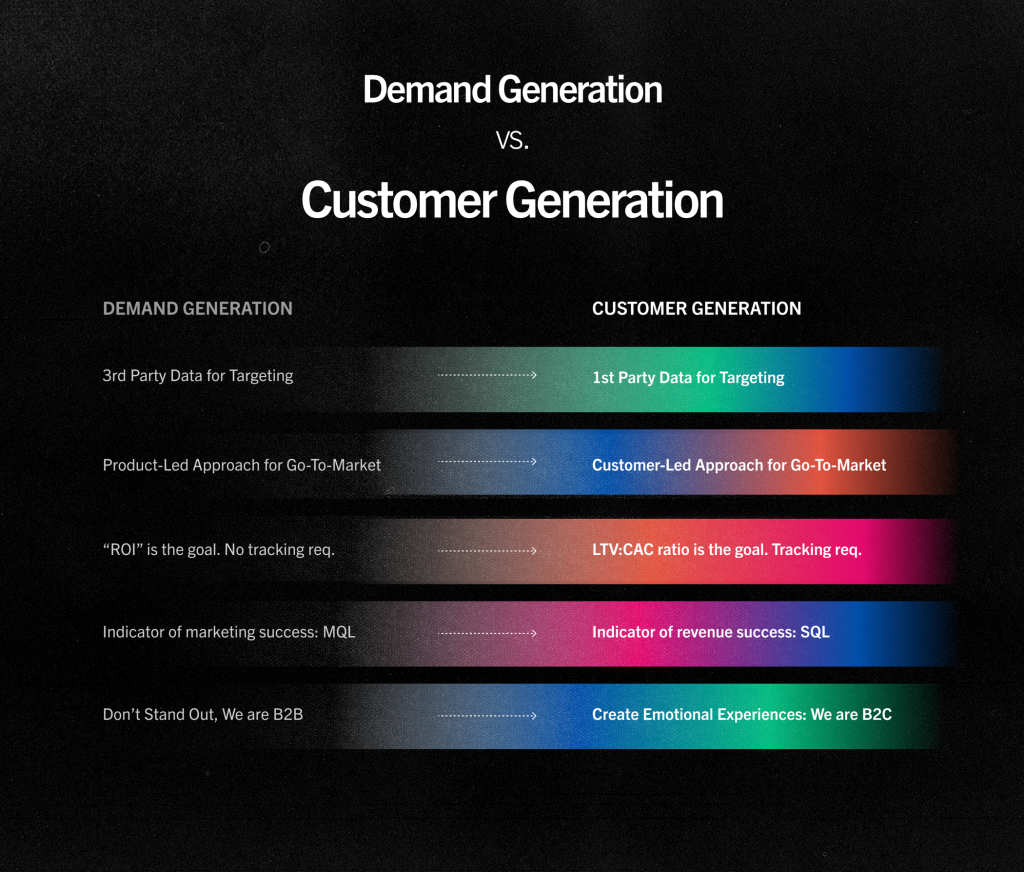
Once you start aligning your strategies, your campaigns, and your metrics towards the people that actually matter instead of the product you’re trying to push, everything becomes powerfully simple. And the results speak for themselves.
How To Implement Your Own Customer-Led SaaS Marketing Strategy
Customer Generation and other customer-led strategies can lead to award-winning results when you know how to get into the head of your audience. Remember that “customer-led” SaaS marketing strategies focus on more than just the customer acquisition part of the journey.
“The modern B2B buyer’s journey is complex. And with the uniquely extended consideration phase of the SaaS space, understanding where the actual value lies within your marketing workflows is vital to scalable growth.”
We’ve broken down our trademarked Customer Generation framework in order to help you better understand just what re-aligning your SaaS marketing strategies looks like. And just in case you’re questioning if Customer Generation is right for you, take a look at what the evolution from traditional demand gen strategies can do.
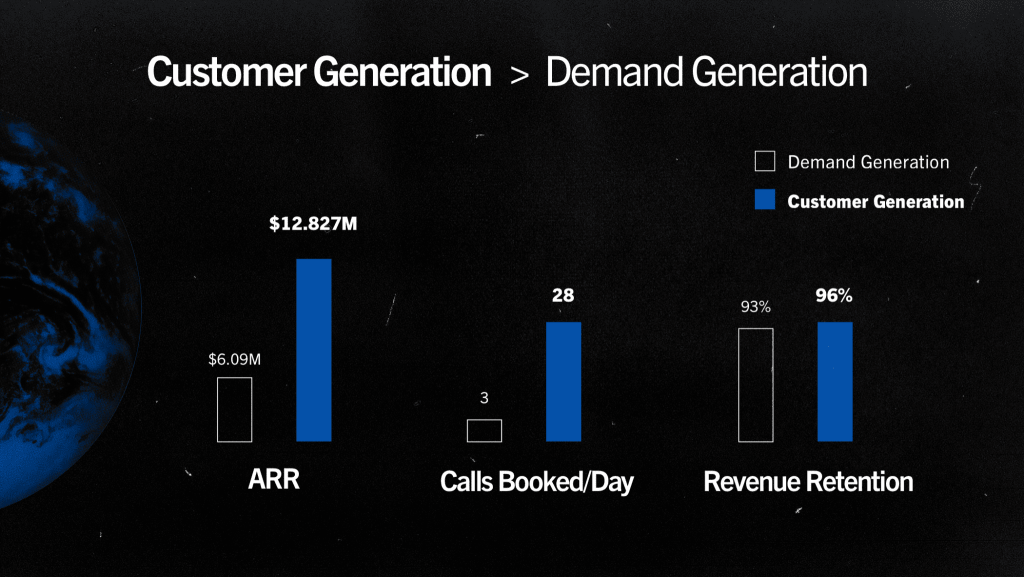
Now that you’ve been convinced – we can dive into the 5 core principles of Customer Generation and get into the nitty gritty of how each of these customer-led implementations will help you move the needle.
1st Party Data Unlocks Scale
Mapping your Total Addressable Market (TAM), building account lists, and aggressively scaling spend using 1st party data not only future proofs your campaigns; but also gives you the confidence to grow brand advertising because every impression delivered will be a future customer.
Customer-Led > Product-Led
Your product is not for the masses. Customer-Led SaaS marketing strategies give you the power to impact business KPIs such as: average contract value, trial conversion rate, lifetime value, customer acquisition cost, and more. By focusing on your most valuable customers, you truly are in control.
Financial Modeling is a Need to Have
Scale without financial modeling is a pipe dream. Make sure you identify your most impactful levers through a customer-led marketing ops agency while acquiring the tools needed to improve your capital allocation.
SQLs Beat MQLs Every Time
MQLs are like balloons. When they inevitably pop, there’s nothing inside. Great marketing makes you money. Let’s keep this one simple.
There’s No Such Thing as B2B
Your customers are people, not corporations. They hate inhumane marketing as much as you do, we promise. Let’s change the expectation of what B2B search marketing is together.
The New Era: Customer-Led SaaS Marketing Strategies
Successful SaaS marketing strategies aren’t defined by the sophistication of their tech stacks or complexity of their marketing automations. A successful SaaS marketing strategy is one that helps you connect to more of your ideal customers. It’s that simple.
“We as SaaS marketers all need to evolve past developing campaigns that serve the busy hands of the marketing team and instead focus on the empty hands of the customers we want to serve.”
Customer-led SaaS marketing strategies that can properly identify, target, and reach their ideal end-buyer will inevitably have an easier time scaling. Which should make that quarterly budget conversation with your boss that much easier next time you bring a Customer Generation strategy to the meeting.
If you’re interested in more innovative and customer-led SaaS marketing strategies, be sure to join Society – a free #Slack community dedicated to SaaS Marketing and Customer Generation!
Looking for a SaaS Marketing partner? Connect with the best Paid Media and SaaS SEO Agency and book an intro call today.
Customer Generation SaaS Community
Customer Generation SaaS Community